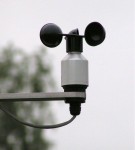– Roy Carver (son of C. E. Carver on Kains Island 1933 – 1944)
One of the daily duties of a light house keeper was to estimate the wind speed during each day and record it, along with other meteorological observations and measurements, which also included sea water temperature, and a sample of sea water which was taken at a depth bellow the surface, weather permitting of course.1

The small glass bottles with cork stoppers of sea water were stored in wooden boxes with many little squares, one for each bottle. These boxes would be shipped out when the supply ship re-supplied the station once a year, usually in July. As far as I know Father never did find out what happened to the bottles of sea water after they left the station.2
For an individual to estimate wind speed is a pretty tall order, especially on the edge of an island. If the wind is blowing in your face one would judge the wind speed higher than if it was blowing from behind you (behind the island), so wind speed estimating was not very accurate, even with the crude wind speed indicating instruments supplied at the station.
When I was very young the supply ship on it’s yearly stop delivered a wind speed indicator. The unit came complete with instructions – to be mounted on a pole as high as possible and the pole to be supported by wires. There was a meter on the wall in the kitchen that was wired to the unit on the pole. All worked splendidly until our first major winter storm hit. During the storm the unit on the pole flew apart and after the storm passed all had gone – the unit, along with the pole and support wires. So Father of course notified headquarters (Victoria) and that was that.
On the next re-supply another wind speed indicator arrived, this one guaranteed to withstand 100 MPH (160 KPH) winds. So Father put up the new unit again with a heaver pole and stronger support wires. Again, all went well until one of the bigger winter storms hit us. I still remember Father excitedly saying the meter in the kitchen was indicating way past 100 MPH. Some time during the night the unit blew apart and was beyond repair. Again Father notified headquarters and that was that, we never saw another wind speed indicator.

So Father decided to build his own. On our yearly holiday trip “Down South” Father purchased two copper toilet tank floats and some 1/8″ brass piping, along with an auto generator and a meter. He cut the copper floats in half, then having four cups which he soldered onto four brass pipes all connected to the generator. It was mounted as before on a pole. This unit measured wind speed well in access of 100 MPH a few times, and was still in use years later when we left the station.
1 Remember, this was 1935, and the lightkeepers were required to give weather reports. This service has been going on for years – it is not something new. The lightkeepers were as dedicated to giving good weather reports then as they are now.
2 The samples were delivered to the Department of Fisheries and Oceans in Victoria, BC (now called Department of Fisheries and Oceans – DFO), where the salinity (amount of disolved salts) was measured in each sample. Pictured above is the monthly average collected from Kains Island from 1935 to 2011(please note, the columns do not line up exactly under the month names, and all temperatures have been converted to degrees Celsius by the computer, even though Celsius was not used officially in Canada until 1970).

The temperatures for Kains Island come from this Fisheries and Oceans link. On this page one can obtain instructions to find pages for Temperature, Salinity, Average temperatures, and a Photograph of many BC lighthouses, past and present, that do collect Seawater information.